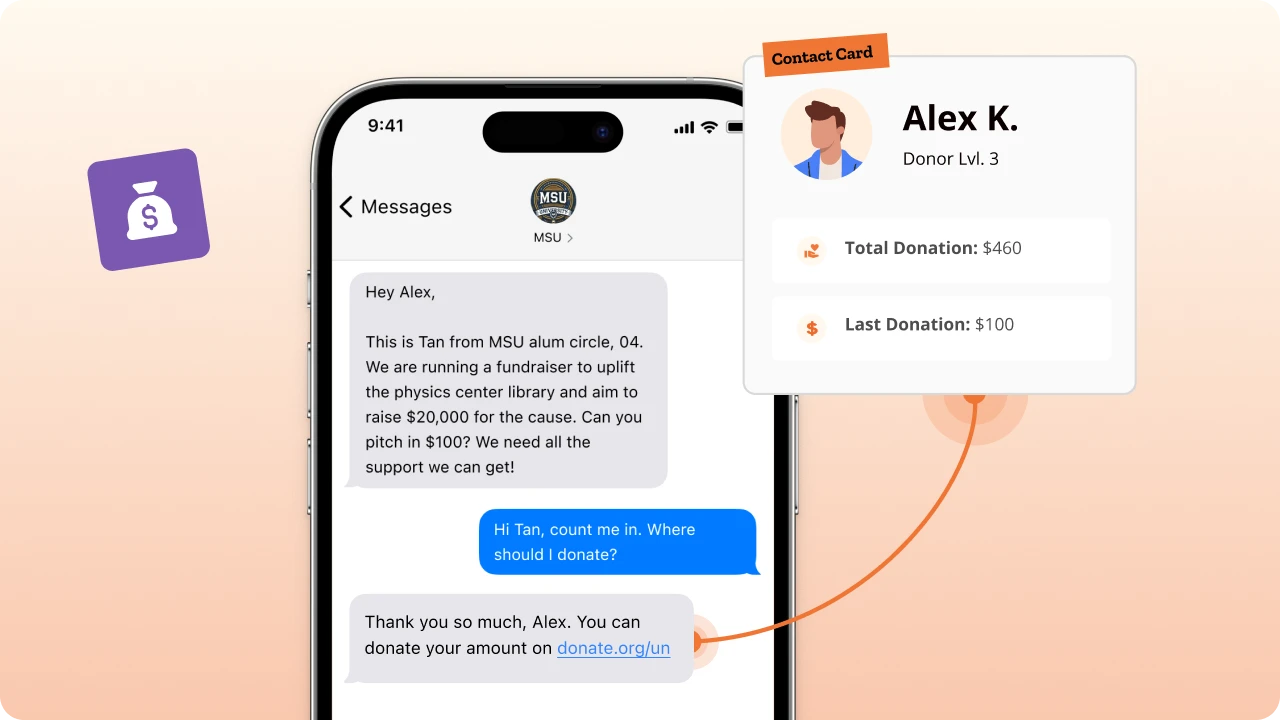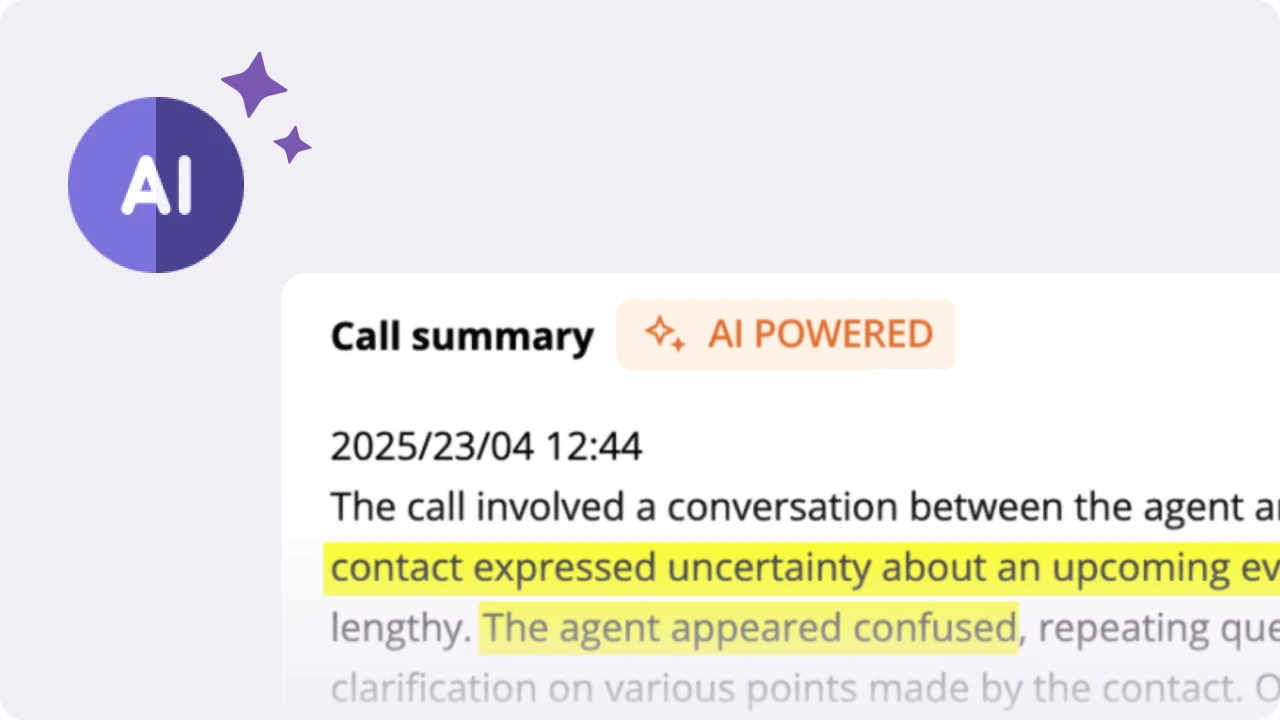Table of Contents
What is political canvassing?
Political canvassing involves having volunteers knocking on doors (or making calls and sending texts) on behalf of a political campaign to engage voters in an election.
Canvassing is done to:
– Increase awareness about an issue
– Identify voter preferences
– Persuade undecided voters to support a campaign
– Get out the vote
You’ve likely seen hundreds or even thousands of volunteers heading out to knock on doors, make calls, and send texts months before elections. Their goal: to have meaningful conversations that persuade voters, gather preferences, and get people to the polls.
Sometimes these efforts sway outcomes; other times, they barely make a dent. The difference usually comes down to a few key factors:
- The allocation of resources
- The tools and channels used
- Flow of information with the campaign office
- (most importantly) The volunteer’s ability to connect with voters.
At its core, success in canvassing comes down to preparation. This guide will show you how to plan and execute an effective political canvassing campaign.
How effective is political canvassing?
Several factors can impact the effectiveness of your canvassing efforts in encouraging people to vote for you. Among them are:
1. How do you target voters
2. Your canvassing timeline
3. What channels do you use to reach voters
To expand on the previous point, the three primary channels that political campaigns utilize for canvassing are door-to-door outreach, phone calls, and text messages.
| Door-knocking | Phone calls | Text messages |
| A study on MoveOn GOTV operations found that turnout increased by approximately 9 percentage points through door-to-door canvassing. | Volunteer-led phone banks have been found to increase turnout by 3.8 percentage points. | Voters getting text reminders voted at a rate 3.1 percentage points higher than those who did not. |
Read Also: How Effective Is Political Canvassing? Everything To Know
Beginning a political canvassing campaign involves assembling a team of individuals that can get the work done, starting with:
Field organizer canvassing job
1. Who are they
Your field organizer is responsible for communicating with and managing the volunteers participating in your canvassing events.
2. What are the responsibilities of a field organizer?
- Recruit, train, and retain volunteers
- Manage volunteers for canvassing, phone banking, peer-to-peer texting, and data entry
- Run GOTV programs via phone, text, and door-to-door
- Build a rapport with the volunteers on behalf of the political campaign
- Planning and executing events by studying demographics to best represent an area/region
- Prepare campaign materials like notices, flyers, and brochures
- Monitor campaigns to see if the goals are being achieved
- Organize fundraising events and local outreach programs
3. What to look for in a field organizer
Since the role involves managing people and tools for canvassing activities, look for individuals who:
- Have strong interpersonal skills
- Have experience handling canvassing tools (ex. CRM’s like NationBuilder orNGP VAN, outreach tools like CallHub or eCanvasser)
4. Hiring a field organizer
Hiring for a campaign is much like hiring for a business. Post an opening on the canvassing job portals like:
- https://www.indeed.com/
- https://www.politicaljobhunt.com/
- https://www.linkedin.com/
- And importantly, on your campaign website

Volunteer for a canvassing job
- Who are they
Besides the candidates themselves, your volunteers are the face of your campaign, in that they interact directly with voters.
- What are the responsibilities of a canvassing volunteer?
- Knocking on doors in their assigned turf
- Making phone calls to voters
- Communicating with voters through peer-to-peer texts
- Answering voter questions (how to register to vote, how to reach a polling station)
- Collecting data from their conversations with voters
- Recruiting volunteers
- Reach out to local communities whose values align with yours or donors who support your campaign.
- Connect with a broader network through CallHub’s Volunteer Opportunities, where volunteers can find campaigns and causes to support.
- Create a volunteer page on your campaign website
- Promote a call to action – Reach supporters through phone calls, texts, and social media
Here’s a canvassing example of a call script to volunteer in your canvassing script:
| We’re looking for voters to help make calls for our campaign! Are you willing to volunteer to help get out the vote? If YES Great! Could you please provide your phone number/email address so we can send you a volunteer link? If NO That’s alright. We look forward to your support this election cycle. If you know anyone else who would like to volunteer, please share this opportunity with them. |
Read also: How To Get Volunteers For Political Campaign: Step-By-Step Plan With Tips
The political canvassing timeline
Canvassing occurs in the months leading up to Election Day. It reaches a high point two months before election day, when the majority of canvassing activities take place.
The typical election canvassing campaign goes in the order of:
- Voter identification
- Voter registration
- Voter persuasion
- Getting out the vote (GOTV)
Depending on the size of the campaign you are running, the resources you have available (in terms of volunteers and voter data), and your proximity to the election, consider allocating more or less time to each stage of voter outreach.
Consider this canvassing timeline for both primary and general elections over the period of 1 year before election day:
| Timeline | Activities | Notes / Focus |
| 12 months before election day | Volunteer recruitment and training | Prepare volunteers well in advance before active voter outreach begins |
| 11–7 months before election day | – Run voter ID campaigns to identify supporters, non-supporters, and undecided voters through phonebanking and door-knocking.- Run voter registration campaigns (follow up with unregistered voters)- Start planning GOTV campaigns using data from voter ID | Focus on building your voter database and segmenting voters |
| 6 months before election day | – Continue volunteer recruitment and training- Run persuasion campaigns targeting undecided voters- Continue outreach via door-to-door, phone calls, and text messages | Engage strong supporters as volunteers and convert undecided voters |
| 2–1 month before election day | – Launch GOTV campaigns to get constituents to the polls- Send follow-up texts with polling locations, deadlines, and early voting info | Prepare voters for election day; start early voting outreach if applicable |
| Tip: If you are canvassing over a shorter period, say three months before the election, it would be advisable to jump straight into GOTV, especially if you have a voter list with all the necessary data. |
Once you have decided on a timeline for your canvassing efforts, it’s time to plan how you will execute them.
The political canvassing process
For a typical canvassing event, the process is as follows:
Step 1: The campaign spreads the word about an event to supporters
Step 2: The campaign prepares for the event – setting up calling and texting campaigns, cutting turf, creating walk lists, and preparing training materials.
Step 3: They gather in a centralized location, ex. A campaign office. This doesn’t apply to distributed calling and texting campaigns.
Step 4: Volunteers are trained on the objective to canvass for votes and how to approach voters.
Step 5: Volunteers receive walk lists, scripts, and campaign literature.
Step 6: Canvassing begins – volunteers reach out to everyone on their walk, fill in data based on their conversations, and leave behind campaign literature.
Step 7: The newly acquired voter information is brought back and entered into the voter database (or synced if the campaign is using a canvassing app or a tool to make calls and texts)
Let’s expand on these steps:
Before canvassing
- Recruit volunteers
Once you have determined the aim and objective of your campaign, it should be easy to calculate the number of volunteers needed to reach your canvassing goal.
| A typical canvasser spends around 1 to 3 minutes at a door, averaging about 20 doors per hour (when we account for time spent walking). So, a single volunteer on a 3-hour shift can knock around 60 doors per shift. |
1. For phone calls: The call rate depends on which dialer you are using.
2 . For peer-to-peer texts: A volunteer can be expected to send out around 1500 texts an hour.
Depending on your mode of canvassing, you can estimate the number of volunteers needed to reach all the voters on your list.
- Set a time and place
When you spread the word about a canvassing event, make sure you communicate these important details:
- The day of the event
- Timings for the event
- Location (if door-to-door canvassing)
- Shifts that volunteers can sign up for
Here’s how Persist Brooklyn communicated their text canvassing event to prospective volunteers.

3. Turf cutting (in the case of door-to-door canvassing)
Turf cutting is the process of dividing a campaign area into smaller, manageable geographic sections (turfs) to assign specific regions to each canvasser for efficient door-to-door outreach.
Distribute a share of your voter universe to each canvasser by assigning them to a geography or a neighborhood.
Preparing these walk lists will consume a significant portion of your canvassing preparation time. Using a CRM tool, this process becomes a bit easier.
| For example, NationBuilder allows you to segment your voter lists and cut turf using a mapping tool. |
Once you cut turfs, either by auto-clustering or manually selecting geographies or neighborhoods, you can print out walk sheets or import the turfs into a canvassing tool.

4. Prepare volunteer materials
In the case of door-to-door canvassing, the walk packet should have:
- The script
- Map with canvassing route
- Contact sheet where volunteers mark surveys
- Clipboard
- Campaign literature
- Water and snacks
Ask your volunteers to download a canvassing app on their phones. You can sync data, including scripts and walk lists, to the app, so all they need is their phone when they are out canvassing.
For calling and texting campaigns, this involves:
- Setting up a calling or texting campaign for canvassing activities
- Uploading a script to the tools
- Creating survey questions that volunteers can fill out on the tool
During canvassing
1. Sign volunteers in
- Get a headcount of the number of people who actually attended the canvassing event. You may need to make adjustments based on the resources available for various canvassing activities.
- Make calls or send texts to volunteers who have RSVP’d and have yet to show up. For the volunteers who do turn up but don’t have their contact information, collect their phone numbers so you can contact them in case you need to relay instructions during the event.
2. Train volunteers
Any good political canvassing campaign starts by getting your volunteers up to speed with a quick, structured training session.

Here’s how you can do it:
| Stage | Activity | Purpose / Notes |
| 1. Introduction | The campaign owner (candidate or campaign manager) gives a short speech | Reiterate the importance of canvassing and campaign goals; motivate volunteers |
| 2. Orientation | Introduce the main agenda of the session | Prepare volunteers for what to expect and what they will learn |
| 3. Campaign briefing | – Present main talking points for the campaign- Explain designated canvassing areas- Train on how to answer questions from constituents- Explain where/where not to place campaign literature- Guide on keeping notes during canvassing | Equip volunteers with essential information and guidelines |
| 4. Team organization | Split volunteers into teams for canvassing | Encourage collaboration and clear area coverage |
| 5. Role-playing exercise | Pair volunteers: one plays canvasser, the other a constituent | Practice real conversations in a safe environment; ensure every volunteer plays each role at least once |
| 6. Wrap-Up | Recap key points and answer questions | Reinforce learning, clarify doubts, and boost confidence before going to the field |
Read also: A Compilation of the Latest Election Campaign Communication Research
After canvassing
1. Follow up
Follow-up is almost as important as the initial voter contact. Use multiple campaign tools to maintain engagement:
- Canvassing (door-to-door)
- Phone calls
- Emails and text messages
- Social media
- Website updates
- Fundraising tools
- Campaign management software
It maintains a seamless flow of engagement from the campaign’s start to election day. If you’re doing door-to-door canvassing, then you should:
- Reinforce messages from previous media outreach
- Leverage data from prior phone banking campaigns (e.g., supporter levels, key issues)
- Target voters with tailored messages based on collected data
Here are some post-contact follow-up strategies:
- Send emails or texts with campaign information and updates
- Include a clear call-to-action (e.g., donate, volunteer, or attend an event)
- Strengthen the connection between the campaign and constituents

Here’s how you can master messaging for each stage of the campaign.
Read also: The Most Common Dos and Don’ts of Canvassing for Political Campaigns: A Last-minute Checklist
Messaging for political canvassing: How do we get it right?
Here are some general best practices for campaigns and volunteers when it comes to door-to-door, phone, and text canvassing, as well as other canvassing activities.
1. Make sure you’re talking to the right person
This best practice applies to phone calls or peer-to-peer texts.
Phone numbers aren’t always accurate, and when you call a landline, the likelihood of reaching a specific voter in the household is relatively low.
Begin your script by verifying that you are speaking to the correct person. If you are not, then do either of the two:
- Ask your volunteers to note that down
- Switch to the appropriate household member (If your phone banking service lets you do so)

If you are using a Predictive Dialer to make calls, remember that there is typically a 1-2 second delay connecting a voter to the caller. When you’re first connected, you can safely assume that the voter has already said, ‘hello,’ so feel free to jump right into conversation with the voter
“Hi, may I speak with {voter_name}?”
2. Positive attitude is contagious.
As discussed, your volunteers are the face of your campaign, right after your candidate. That means it’s worth taking the time to make a good impression.
Here is how volunteers can create one:
- Always thank voters for their time, regardless of how the conversation unfolds.
- Smile genuinely to create warmth and trust.
- Maintain your energy levels to ensure your enthusiasm shines through in your voice.
- Use natural body language, such as standing, walking, and gestures, to stay engaged.
Read Also: Here’s an article by Harvard Business Review on authentic speaking.
| Tip: A positive attitude and body language are also important for calls. |
3. Convince through social pressure
Messaging that attempts to convince voters to take action through social pressure has been found to be effective.
This can be done by:
- Sending an email or letter with someone’s past voting history
- Thanking them for voting in a previous election
- Showing them that the people around them vote
The Progressive Turnout project sent over 87,000 social pressure mailers to voters in 2018, and cited an 8% increase in voter turnout.

It is important to note that social pressure that treads into the realm of shaming voters can result in backlash, especially in the long term.
Identifying Supporters
Voter ID campaign efforts at the start of your campaign help you narrow down your voter universe for persuasion and GOTV efforts down the line.
As we saw in the canvassing timeline, it’s important to start the voter ID campaign as soon as you have access to your voter list and a sizable number of volunteers. Voter ID revolves around data collection, because you want to know:
- How strongly a voter supports your candidate
- Their key political views
- Whether they are a potential volunteer for your campaign
- Whether they are registered to vote
The best way to do this is by having volunteers ask direct questions. Your voter ID survey should look something like this:
| Question 1: Do you support {candidate name}? Response 1.1: Strong Support Response 1.2: Leaning support Response 1.3: Undecided Response 1.4: Leaning Opposition Response 1.5: Strong Opposition Question 2: Can I ask you about issues you care about at the moment? Response 2.1 – 2.8: Health, Environment, Climate Change, Transport, Agriculture, Education, Jobs, Immigration. If supporter is strong leaning Question 3: Would you consider volunteering to help elect {candidate name}? Response 3.1: Phone banking Response 3.2: Text banking Response 3.3: Canvassing Response 3.4: Data entry Response 3.5: Other Response 3.6: Not interested Question 4: Would you consider donating to {candidate name} campaign? Response 4.1: Yes Response 4.2: No Response 4.3: Already did Response 4.4: Ask me later Question 5: Can we put up a lawn sign for {candidate}? Response 5.1: Yes – Lawn sign Response 5.2: Yes – Poster Response 5.3: No If they are leaning or undecided Question 6:Would you consider voting for {candidate name} If NO Question 7: Who will you be supporting? Collect the name of the candidate Question 8: We want to make sure we have the right address. Can you confirm {address}? If NO, collect the new address Question 9: Can we have your email address to keep in touch? |
Please note that the request to join your campaign as a volunteer is made during the voter ID stage. This saves you the effort of running an additional campaign only for volunteer recruitment. Similarly, you can help voters get registered to vote once you have their registration status.
Voter Persuasion
Voter persuasion involves contacting undecided voters and convincing them to vote for your candidate.
You can start your voter persuasion campaign as soon as you have identified your voter list (but not too far in advance of the election, as that can serve to annoy voters).
Deep canvassing is a technique that focuses on changing the minds of voters through two-way conversations. That means volunteers need to be as adept at listening as they are at speaking to voters.
During the 2020 U.S. elections in Michigan, We The People Michigan trained 315 volunteers across 16 counties to conduct deep canvassing using:
- Phone calls
- Texts
- In-person conversations with narrative messaging that explores race and class
They reached 35,000–40,000 voters by phone and approximately 200,000 by text, achieving an 80–90% volunteer retention rate. Engagement was strongest when canvassers were from the same community.

In a nutshell, the deep canvassing process involves:
- Asking for a voter’s opinion on a certain issue and exploring it
- Asking for their personal story or experience pertaining to the issue
- Connecting a personal story to the voter’s initial opinion
- Engaging with their initial concerns and opinions, and giving them time to ponder
- Getting back to the original issue and seeking their opinion
Read Also: Your First and Complete Guide on Deep Canvassing
Getting Out The Vote
GOTV (Get Out the Vote) canvassing involves targeting likely supporters of your campaign and persuading them to vote in the final stretch of the election.
During the initial stage of GOTV, it is crucial for the script to engage the voters in creating a plan for how and when they vote. Right before the election, your scripts should be tailored toward getting out the vote.
Structure your script in this way:
- Start with an introduction – The name of the canvasser and the campaign
- Ask them if they are planning to vote in the coming election
- Engage the voter – If the answer to the previous question is yes
- Help the voter create a plan of action – How will they get to the polls?
Here’s a canvassing example of a GOTV script:
| Hello, may I please speak with <name of the voter>? My name is <name of volunteer>, and I’m a volunteer/student intern on behalf of <name of your campaign>. A few weeks ago, you promised to vote for <name of your candidate> on Election Day <mention the date> Do you still intend to vote on <date of polling> for <name of your candidate> If yes: Great! An early voting period is <give the time>, and your polling place is at <mention the location>. Do you know where that is? {Help them if they are unaware as to where it is} Thank you for helping us. If no: Thank you for your time. Have a great day! |
Political canvassing laws
Make sure you are aware of the regulations surrounding your chosen canvassing method before starting:
What are the laws for door-to-door canvassing
Local governments cannot restrict people from going door-to-door for noncommercial purposes between 9 a.m. and 9 p.m.
If a homeowner has made it clear that canvassers are prohibited (for example, with a sign on a door), canvassers may be charged with defiant trespassing.
In the case of literature drops, it is a federal offense to put campaign literature in a voter’s mailbox. Hand them literature during or after your discussion, or at the door.
What are the laws for political phone banking?
Different countries have different regulations for political phone calls. For example, in the US:
- Campaigns can make automated calls to landlines without prior consent, but prerecorded calls must identify the sender
- Political calls to cell phones require prior express consent and include prerecorded messages
- Every robocall must clearly state the candidate or party at the start
- Calls must provide a way for recipients to opt out of future calls
- Campaigns must honor do-not-call requests promptly
- Always ensure scripts and outreach comply with FCC regulations and updates
What are the laws for political text messaging?
Similar to phone calls, there are FCC rules for texting as well. You are not allowed to send automated text messages (mass texts) to voters without their prior consent. Peer-to-peer text messages, on the other hand, are allowed (since volunteers send texts manually).
If you plan to send automated texts:
- Get an opt-in from new contacts
- Make sure existing contacts on your list are opted in
- Honor opt-outs
Canvassing methods
Here is a comparison of the three most common methods of political canvassing:
| Aspect | Door-to-Door Canvassing | Phone Canvassing | Text Canvassing |
| Remote Capability | Volunteers must be on-site at the voters’ location | Volunteers can participate from anywhere using phone banking software | Works similarly to phone banking, but here you are sending text messages. |
| Persuasive Effect | Strongest effect; can increase voter turnout by ~9 percentage points | Moderate effect; volunteer-led phone banks can increase turnout by ~3.8 percentage points | Slightly lower effect; text reminders increase turnout by ~3.1 percentage points |
| Time Requirement | Requires the most time and volunteers to reach voters | Requires less time than door-to-door but more than texting | Requires the least time and resources |
| Cost Considerations | Software for canvassing, campaign materials, volunteer refreshments, and transport | Calling tool subscription, cost per call | Texting platform subscription, cost per text |
| Volunteer Requirement | Assuming 20 doors per volunteer per hour, calculate based on the total doors | Sepends on dialer type: a)Auto Dialer ~120 calls/hourb)Predictive Dialer ~45 calls/hourc) Power Dialer ~110 calls/hourd) Preview Dialer ~30 calls/hour | Volunteers can send 1000+ texts per hour; calculate based on total contacts |
| Available Tools | eCanvasser, MiniVAN, Polis, Organizer | CallHub | CallHub, Hustle |
Let’s take a closer look at some of the tools you can adopt for canvassing.
Door-to-door canvassing tools
We previously discussed the impact of door-to-door canvassing. Many campaigns (especially local ones) still use pen and paper to cut turf and collect data from voters. Using a canvassing tool can save a campaign both time and money. Let’s explore some of them:
1. Ecanvasser
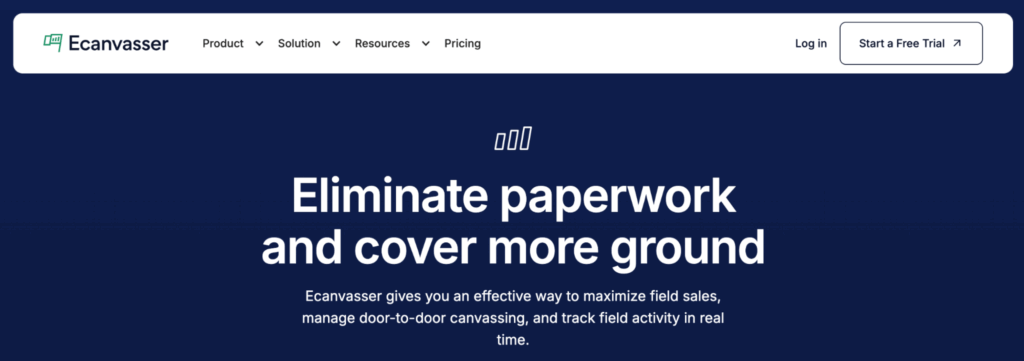
The Ecanvasser app makes it easier to manage field activities through intelligent maps to find voters and real-time tracking of canvassers. Ecanvasser’s integration with Nationbuilder lets you plug in data from the CRM for canvassing campaigns.
2. Knockio
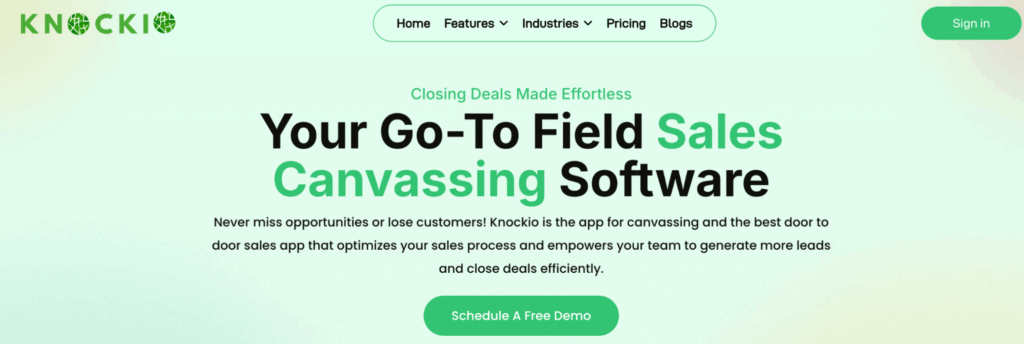
Knockio is a cloud-based canvassing tool that helps campaigns manage door-to-door operations with real-time tracking, route optimization, and customizable forms. It also integrates with CRMs to keep voter data centralized and accessible
4. MiniVAN
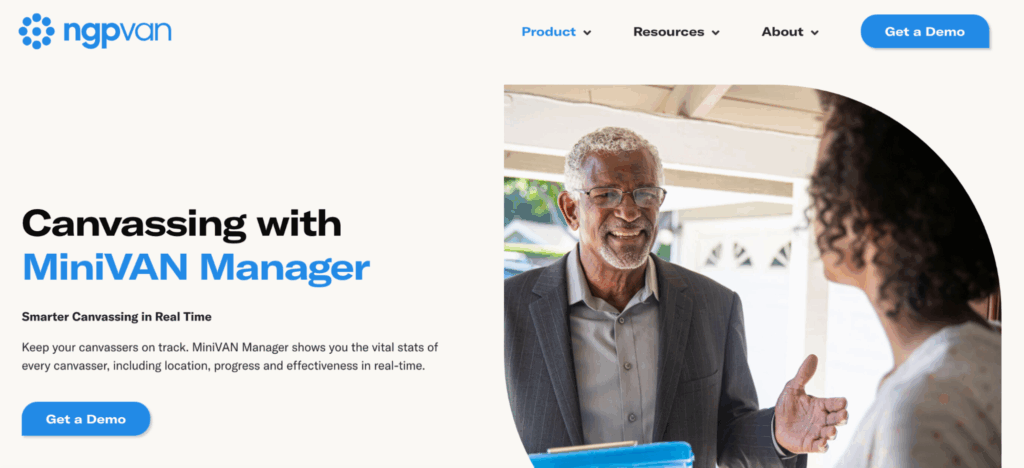
MiniVAN is NGP VAN’s mobile canvassing app, providing volunteers with real-time access to maps, walk lists, and scripts on iOS and Android devices. It includes optimized routing, team canvassing, early and absentee voting integration, and in-app notifications to improve efficiency
Phone canvassing tool: CallHub
A phone banking tool like CallHub lets you:
- Run campaigns with automatic dialing, making at least 3X more calls per minute than manual dialing
- Integrate with political CRMs
- Access unlimited volunteer accounts
- Enables callers to record voter contact history and survey responses.
CallHub offers four dialers to choose from. Depending on the number of people you are calling and the objective of your campaign, you can use the following:
Text canvassing tool: CallHub
CallHub enables campaigns to:
- Send mass texts to large groups of supporters
- Conduct peer-to-peer (P2P) texting, allowing volunteers to send personalized messages
- Record survey responses and track voter engagement through P2P texting
- Use 10DLC numbers to ensure message deliverability and compliance
- Shorten URLs to track clicks and supporter engagement
- Set up automatic replies to respond to supporters instantly
- Filter profanity in messages to maintain professionalism
- Send MMS and RCS messages with images, audio, or video
Read Also: 20+ Political Campaign Tools You Need to Win Elections
Make your canvassing efforts count
Political canvassing is a powerful way to:
- Engage voters
- Build support
- Drive turnout when executed strategically.
From door-to-door outreach to phone and text campaigns, success depends on careful planning, effective volunteer management, and the right tools.
Platforms like CallHub streamline calling, texting, and volunteer coordination, enabling your campaign to reach more voters efficiently and measure engagement in real-time.
Get started with CallHub today
FAQs on political canvassing
What does canvassing mean?
Canvassing is reaching out to people directly through door-to-door visits, phone calls, or text messages to engage them about a campaign or issue.
Is political canvassing considered soliciting?
No, political canvassing is not commercial soliciting. It’s considered free speech, but volunteers must respect “No Soliciting” signs and local regulations.
What is election canvassing?
Election canvassing is contacting voters to raise awareness, identify supporter levels, persuade undecided voters, and encourage turnout on election day.
What to say when canvassing?
Introduce yourself and the campaign, ask if they support your candidate, discuss key issues briefly, and—if appropriate—encourage voter registration, volunteering, or voting plans.
What does a canvassing job involve?
A canvasser talks to voters or the public about a campaign, issue, or organization—usually through door-to-door visits, phone calls, or text messaging.

